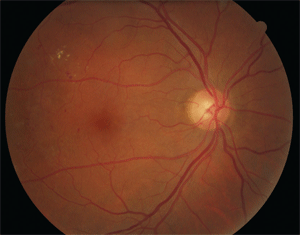Intravitreal injections of triamcinolone acetonide (Kenalog, Bristol-Myers Squibb) may slow the progression of diabetic retinopathy, according to a study in the December issue of Archives of Ophthalmology.
Could this patient with mild diabetic retinopathy benefit from intravitreal Kenalog (Bristol-Myers Squibb)?
In this study, the researchers randomly selected 840 eyes with macular edema to receive laser photocoagulation, 1mg injections of triamcinolone or 4mg injections of triamcinolone. The researchers obtained fundus photographs at baseline as well as at one-, two- and three-year follow-up.

Photo: Daniel Bintz, O.D.
At two-year follow-up, the researchers documented retinopathy progression in 31% of 330 eyes treated with photocoagulation; 29% of 256 eyes treated with 1mg doses of triamcinolone; and 21% of 254 eyes treated with 4mg doses of triamcinolone.
The researchers noted that these respective statistical differences were sustained at three-year follow-up.
Despite the relative success of triamcinolone acetonide injections, “use of this intravitreal corticosteroid preparation to reduce the likelihood of progression of retinopathy is not warranted at this time because of the increased risk of glaucoma and cataract associated with intravitreal steroid use,” says lead author Neil M. Bressler, M.D., of Johns Hopkins University School of Medicine in Baltimore, Md. “Any treatment to be used routinely to prevent proliferative diabetic retinopathy likely needs to be relatively safe because the condition already can be treated successfully and safely with panretinal photocoagulation.”
Bressler NM, Edwards AR, Beck RW, et al. Exploratory analysis of diabetic retinopathy progression through 3 years in a randomized clinical trial that compares intravitreal triamcinolone acetonide with focal/grid photocoagulation. Arch Ophthalmol. 2009 Dec;127(12):1566-71.

